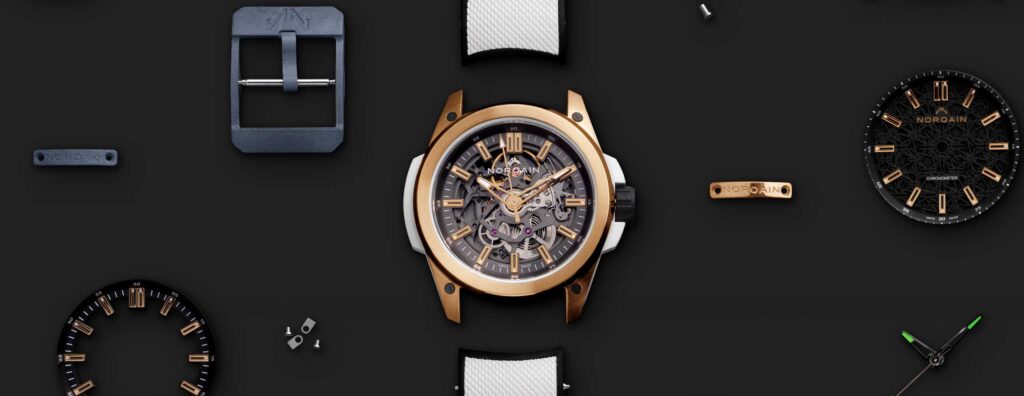Uncategorised
First Look At Bulgari’s Stunning New L’Ammiraglio Del Tempo [VIDEO]
Uncategorised
First Look At Bulgari’s Stunning New L’Ammiraglio Del Tempo [VIDEO]
For some absurd reason, there are some people who still don’t think of Bulgari as being a company that produces technical watches. This is despite the fact that they have created — with the aid of their assimilated workshops from Daniel Roth and Gerald Genta — watches such as the automata repeaters “Il Giocatore” and the Commedia dell’Arte series. In their repertoire of complicated watches they also boast a perpetual calendar grande et petite sonnerie with Westminster chimes and a particularly beautiful-sounding tourbillon minute repeater with carillon (that is, playing more than two notes) chimes. One can only conclude that those people who don’t think of Bulgari as a company capable of the most technically impressive watches probably just aren’t thinking very much about Bulgari at all.
Something is going to change all that this year, and that something is called L’Ammiraglio del Tempo, the Admiral of Time. It is a chiming watch, and lately Bulgari have specialised in some of the best-sounding minute repeaters I’ve heard, ever. They look spectacular as well. Case in point: the Daniel Roth Carillon Tourbillon is one of those watches — partially openworked, alternately darkly matte and brightly polished with a wide-sprawled, good-tempered tourbillon — that makes you want to wait until a minute when no one’s watching, cram it into your mouth and then furtively walk away.
The Ammiraglio del Tempo is built along the same lines, with a rather stricter demeanour; but that’s okay, because the timepiece has some serious business to do. You can immediately see that it’s a chiming watch, because of the visible gongs and hammers visible through the front of the watch. In fact you can see it’s a carillon repeater because of the number of hammers and gongs. But where’s the expected minute repeater slide? There’s no lever as we know it. There’s no push button. The repeater actuator isn’t built into the crown. You see the repeater main lever dipping out of sight under the bezel — but where’s the slide?
In a masterful stroke that made me want to push my chair over and euphorically swear at the top of my voice when I first discovered it (still does, to be perfectly honest), the repeater actuator is hidden in plain sight — it is the bottom left lug of the watch. Just you grab that lug and slide it about 30° clockwise. Then, ladies and gentlemen, boys and girls, you will see some good fun. The Ammiraglio del Tempo is a Westminster minute repeater, meaning it chimes the tune of the Big Ben clock (one bar of four notes for each quarter and all four bars on the hour). It sounds stupendous — but you don’t have to believe me. I got video to prove it. It’s loud, and it sounds good, and it’s the perfect speed — I don’t know what they’re feeding the high complication watchmakers at Bulgari, but clearly it’s the good stuff.
By itself, this would already be pretty impressive. Ladies and gentlemen of the jury, this is not all. Look at the balance at six o’clock and tell me what you see. Is it — could it be — is it really? A pivoting detent escapement with constant-force mechanism to supply even torque to the notoriously high-maintenance detent escapement, did you say? You’re so right I can’t even tell you. How high maintenance is the detent escapement? If the detent escapement was a woman she’d be Naomi Campbell, how about that.
And now, let’s go on a little expedition down the isthmus of complication and into the treacherous straits of escapement. Warning: history and mechanical engineering theory ahead.
The vast majority of mechanical timepieces use Swiss lever escapements to supply power to the regulating organ. How vast exactly is this majority, you ask? Let’s put it this way — the number that expresses the remaining, minority percentage only consists of non-zero integers when you look at least five spaces to the right of the decimal point. This extremely small remaining percentage of mechanical watches that do not use the Swiss lever escapement use instead variations of the Robin escapement (such as in the case of the Audemars Piguet ChronAP), Abraham-Louis Breguet’s natural escapement (the Laurent Ferrier Galet Micro-Rotor) or the detent escapement. The first recognized detent escapement was a 1748 invention of pioneering clockmaker Pierre Le Roy. The mechanism was subsequently refined by horological luminaries such as John Arnold, Ferdinand Berthoud and Thomas Earnshaw (of the bimetallic self-compensating balance), and it’s safe to say that, had the detent escapement not been invented, the world as we know it today would be very different.
By the early years of the 18th century, maritime explorers were confident in navigating through different latitudes with great accuracy, since the octant and similar instruments constructed on the principles of astronomical geometry enabled them to determine latitudinal positions with reference to the sun or the North Star. Sea voyages could be safely conducted on a mostly north-south axis, with periodic references to the coast to determine exact location. The problem arose when it was necessary to sail east or west. Calculating longitude while at sea was theoretically possible — all one had to do was invent an accurate enough timekeeper that, combined with the height of the sun in the sky, would allow the navigator to calculate his distance from a reference destination, in terms of longitudinal degrees. However, no one had yet managed to build a timepiece that would keep time scrupulously in spite of the pitching and yawing of a large ship.
When John Harrison presented the first successful marine chronometer, the H4, the floodgates were opened. The H4 used a novel escapement of Harrison’s own invention, but subsequent high-performance marine chronometers used improved versions of the detent escapement, and the practicality of these designs eventually meant that most marine chronometers were distinguished by the use of a detent escapement. (To this day, another name for the detent escapement is chronometer escapement.) The detent escapement, then, was what accelerated the Age of Discovery and the era of empire building. The world powers of the 19th centuries, the signposts for the foundation of the modern era, were precipitated by the realisation of accurate marine timekeeping.
With the Ammiraglio del Tempo spearheading Bulgari’s fleet of high complications, poised to open up new realms of horological conquest, it’s only appropriate that the detent escapement guides the beating of this timepiece. The detent escapement is built upon three fundamental horological principles. Firstly, the balance should be disturbed as little as possible and left to oscillate as freely as it can — the entire category of detached escapements centers on this axiom, and is the reason behind the exceedingly poor performance of early escapements such as the verge or cylinder. Secondly, the locking of the escape wheel and the impulse of the balance should be separated for higher energy efficiency. Thirdly, direct-impulse escapements are superior in that they do not require lubrication and hence avoid all the problems associated with the deterioration of watch oils.
For the above three reasons, the detent escapement is particularly well suited for high-performance timepieces. The disadvantages of the detent escapement, however, are that it is extremely sensitive to shock, difficult to miniaturize and that traditionally it does not self start. The first disadvantage is especially problematic in a wristwatch, since the wrist is subject to one of the highest amounts of positional variation among all the parts of the human body. Upon receiving a sudden shock, the escape wheel is liable to unlock accidentally, allowing the mainspring to rapidly wind down, stopping the movement and potentially damaging it in the process. Bulgari have addressed this problem by modifying the detent arm and incorporating an additional level to the safety roller. The detent arm terminates in a curved lever of a very precise shape that travels along the outer edge of the additional level on the safety roller. In the case of a sudden shock that might in traditional detent escapements dislodge the detent arm and unlock the escape wheel, the lever presses against the safety roller and prevents the locking jewel from slipping out from under the teeth of the escape wheel. The safety roller features a cut out to accommodate the lever when the roller jewel releases the detent arm and unlocks the escape wheel.
The balance in the Ammiraglio del Tempo utilizes a cylindrical hairspring — as in the marine chronometers of old — and while this type of hairspring is characterized by improved concentricity in breathing, it also tends towards extreme amplitudes. Detent escapements fitted with cylindrical hairsprings are doubly vulnerable to anomalous oscillation, since the balance is only impulsed in one direction and oscillates unchecked in the other direction. The large vibrational amplitude that a cylindrical hairspring can create may send the balance more than 360° around its axis, tripping the escape wheel in an action that francophone watchmakers describe as “galop” — a word that conveys extreme disapproval, especially when used in context of the orderly business of watchmaking. Helping to regulate this, the balance assembly is geared to a security wheel via a pinion near the base of the balance staff. The security wheel is tensioned with a spring and prevents excessive rotation of the balance while allowing it to oscillate freely at standard amplitudes.
That’s quite enough, I think, and if there’s still any more doubt in anyone’s mind about whether Bulgari is capable of creating astounding timepieces at the very pinnacle of horological achievement, let the Ammiraglio del Tempo finally put those doubts to rest — in Davy Jones’ locker.














